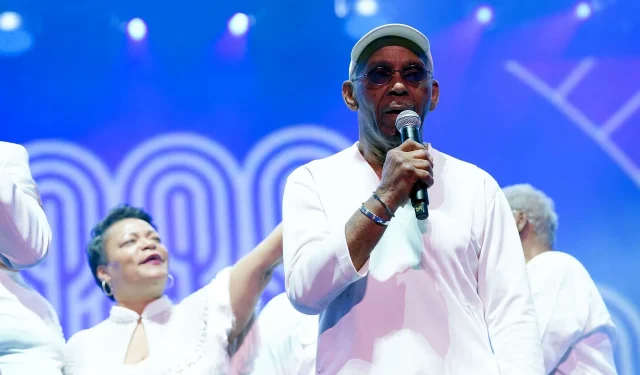
Frankie Beverly, the renowned R&B, soul, and funk singer-songwriter and producer, passed away on Monday, September 10, at the age of 77. His family announced the tragic news via Instagram the following day. As of this writing, the cause of his death has not been revealed.
“He lived his life with pure soul as one would say, and for us, no one did it better. He lived for his music, family, and friends. Love one another as he would want that for us all,” read the post from September 11.
The family also requested privacy during this deeply personal and emotional time as they grieve for Frankie Beverly.
A week following his death, fans gathered in New Orleans, where Beverly spent much of his life, to honor him by participating in a mass second line parade.
For those unfamiliar, a second line is a group of dancers, musicians, and performers who follow a brass band in traditional New Orleans parades, which originated as part of funeral celebrations.
The videos capturing the parade in memory of Frankie Beverly, held on September 16, went viral, showcasing hundreds dressed in white as they walked, danced, and sang, all while carrying a casket with a cardboard effigy of the beloved musician inside.
Amid the clips going viral, social media users shared varied reactions. For instance, Instagram user @theyallwannasmokehaze commented on the cardboard effigy inside the casket on a post by The Shade Room.

Many others also commented on the video posted on X, expressing their thoughts on the casket display.
“Wow, they have a casket with a picture of him on the street & dancing with it? More like a weird send-off to me,” a person wrote.
“New Orleans is not a real place, fr. how you give Frankie Beverly a second line AND put a cutout of this man in a clear casket with real pallbearers,” one remarked.
“Not only did New Orleans have a second line for Frankie Beverly, they had a whole casket,” wrote another.
Conversely, many praised the city of New Orleans for providing a fitting farewell for the singer of “Before I Let Go.”
“New Orleans really gave Uncle Frankie the second line of a lifetime. You hear me? This city is not a real place—but in the best way,” a netizen remarked.
“I said that New Orleans was going to have a second line for this man because one thing’s for sure love our city and we love you back Frankie Beverly has been coming to New Orleans for years you rest in positivity. RIP Frankie Beverly,” another user stated.
“Everybody understood the assignment! This how you come together as a city for a legend,” an individual commented.
“Well deserved second line because like I said before Mr. Frankie Beverly has been coming to New Orleans for years, and he has been at every essence and jazz festival ever hosted in New Orleans. We will miss him dearly now you can rest easy Mr. Frankie Beverly,” another added.
Exploring the significance of New Orleans’s second line in the wake of Frankie Beverly’s final send-off
According to NewOrleans.com, a second line is a “quintessential New Orleans art form – a jazz funeral without a body.” Its origins lie in African-American culture, initially started as neighborhood parades offering social aid to freed slaves, providing loans and insurance, functioning as a form of advertising.
Over time, the second line gained popularity as a way to celebrate the lives of those who passed within the community, becoming part of memorial services. In contemporary settings, it has also been incorporated into weddings and various notable New Orleans events, such as French Quarter Fest and Satchmo Summerfest.
The term “second line” refers to the two lines or sections of a parade. The front line features the parade leader or grand marshal along with a band and the person being honored. Behind them follows anyone who wishes to join in the celebration, including extended family, friends, and admirers.
Each year in New Orleans, thousands of second lines occur, especially popular during Sunday afternoons. In funeral second lines, the hearse is transported from the memorial site to the cemetery, with family, friends, and other attendees in tow, often accompanied by a jazz band to commemorate the life of the deceased.
Frankie Beverly’s funeral second line was organized on Monday by the 6 Ward Steppers Social Aid and Pleasure Club in the Treme neighborhood of New Orleans, starting at 6:30 PM.
In brief, looking at the legacy of Frankie Beverly
Born Howard Stanley Beverly on December 6, 1946, in Philadelphia, Frankie began his music career singing gospel as a child and later formed a cappella group called The Blenders. However, it was short-lived and soon evolved into another group named The Butlers in the early 1960s, which gained traction with the single “If That’s What You Wanted.”
Despite their initial lack of recognition in Philadelphia, the group began touring, making significant stops in San Francisco and New Orleans, where they found their footing.
Undergoing several name changes, the band eventually became known as Maze in the 1970s, producing iconic soul and funk hits such as “Joy And Pain,” “Before I Let Go,” “Back In Stride,” “Running Away,” “We Are One,” and “Happy Feelin’s,” among others.
Frankie Beverly maintained a deep connection with New Orleans throughout his career. In May 2024, he performed at the city’s Smoothie King Center during ‘The I Wanna Thank You Farewell Tour’ to a packed crowd of 14,000 fans.
Earlier that same year, he was part of the New Orleans Jazz & Heritage Festival, and in July, he received a tribute at the Caesars Superdome during the Essence Festival of Culture.




Leave a Reply